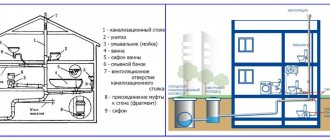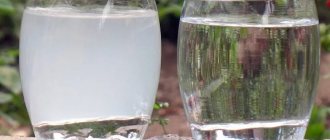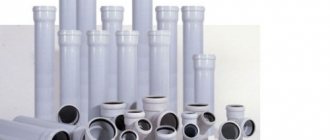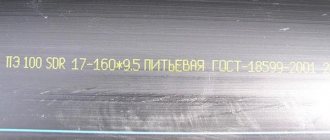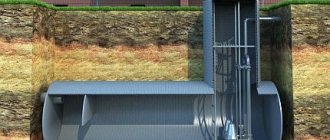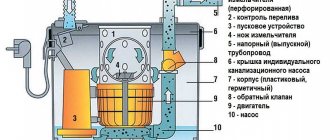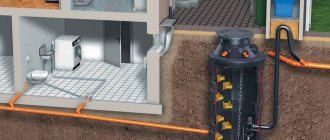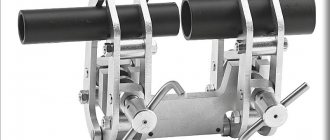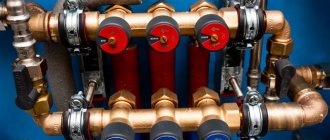A sewer pipe is a part of the pipeline system that provides a connection between the sewer riser (which drains wastewater from plumbing fixtures) and the atmosphere. The sewer pipe performs a barrier function: if it is present, gases that accumulate in the drainage network do not leak into the living space. In addition, it performs a soundproofing function. Such a product is presented on the market in the form of cast iron, copper or plastic (PVC) blanks. The most popular option is the use of plastic products.
A drain pipe is a sewerage element that provides air flow into the system
How to choose the right drain pipe diameter
Even at the stage of the initial design documentation, the dimensions of the sewer pipes in the future building must be agreed upon. In 90% of cases, parts with a diameter starting from 100 mm are used to install a wastewater system in a bathroom. To install the system in the bathroom or kitchen, it will be enough to use a 50 mm pipeline. The difference in the given values was chosen for a reason. It is determined by several factors:
- A toilet is a plumbing fixture, the peculiarity of which is the passage of a significant volume of water in a short period of time (when the flush button is pressed). At the same time, the water may contain solid particles, which will be problematic for elements of the waste structure with smaller circumferences than those given above to cope with. There is a high probability of blockages.
- Even without looking at the fact that when draining water from a bathtub, its volume is no less than the volume of water from the toilet, the diameter of the sewer pipe will be smaller due to a simple rule of hydraulics - the permeability of the system should be equal to the value provided in the place with the narrowest circumference parameter. This release value in the bathroom is significantly less than in the toilet. Therefore, it is impractical to mount parts with a large diameter.
Required pipe slopes (Example - 1:30. Where 1 linear meter per 30mm slope)
Ring stiffness classes
Sometimes in the tables there will be letters and numbers that are unclear at first glance. For example, SN 2 . This is the ring stiffness class. It is measured in kN/m2.
The parameter makes it clear how much the pipe can withstand vertical loads without deformation.
Let's give some brief characteristics:
- SN 2. Withstands pedestrian traffic only.
- SN 4 . Able to cope with passenger vehicles.
- SN 8 . They do not get “flattened” by trucks.
The weaker the soil is compacted, the larger the number should appear after SN .
Advantages of plastic
Any structural element made from the above materials has the following advantages:
- Resistant to a variety of chemicals, for example, solvents or alkalis.
- Strength , allowing the part to be immersed in the ground at a distance of up to 16 m.
- a smooth surface inside , creating an obstacle to the formation of plaque.
- Low weight . With a length of one hundred centimeters, an element with a circumference of 110 mm weighs about 1.5 kg.
List of sewer fittings
Only fittings are capable of combining pipes of different types and sizes. Used to connect branches and when turning a structure. The reliability of the system's sealing depends on correctly selected connecting parts.
| Name of the connecting element | Functionality |
| Tee 110×110 mm | Large fitting, used to connect to the central riser and toilet. |
| Reduction 110×50 mm | A special type of fitting that connects pipes with a diameter of 50 mm to a diameter of 110 mm. |
| Bends | Elbows designed to change the direction of pipelines. Suitable for all sewer sizes. Can be installed at an angle of 90° or 45°. |
| Tees | Several pipes are connected into one system. Can be all sizes identical or different. |
| Audit | Designed for places with an increased risk of contamination, equipped with special removable covers. |
| Stubs | They are selected for a certain pipeline diameter and installed at the ends. |
Size and place of application of PVC products
The production of polyvinyl chloride pipes is regulated by GOST R 51613-2000 , or the VSN 48-96 . For the production of pressure parts the specified GOST is used, and in the production of non-pressure parts the standard is applied.
According to the data given in the standard, the diameter of non-pressure PVC sewer pipes can be:
- 50mm.
- 90mm.
- 110mm.
At the same time, plastic pipes for sewerage, the dimensions of which in length range from 0.5 to 8 meters, have an internal wall thickness of at least 3.2 mm.
GOST R 51613—2000
Differences between pressure pipelines and non-pressure pipelines
The differences between pressure pipelines will be significant from the specified parameters of non-pressure systems. For example, the number of standard sizes of these products is 13 pieces. At the same time, PVC sewer pipes, diameter sizes range from 63 to 315 mm.
The presence of such a choice of sizes plays into the hands of construction organizations. However, the following pipe diameter options are often used:
- 7.5 cm. The product is used for making taps in bathrooms.
- 10 and 11 cm. Such parts are used for carrying out the external pipeline and riser.
- 20 and 30 cm. The products are used for drainage systems in industrial buildings.
Diameter of pipes - internal and external sewerage systems
Tips for repair and operation
Correct joining and routing of sewer lines is possible only with the help of standard drain tees and bends.
The height of the pipe above the roof must comply with established building codes and regulations.
To ensure good traction, the beginning of the fan riser in a private house should be located in a room where the temperature is higher than outside the building.
The top edge of the vent pipe should not be placed in the attic. Otherwise, the rafters may rot, and the thermal insulation material of the ceiling will become saturated with moisture.
Installing a deflector has advantages and disadvantages. This device prevents clogging of the ventilation, and in some cases increases draft. But in the cold season, the deflector contributes to the formation of condensation and subsequent icing, which will lead to a decrease in the ventilation opening.
Between the riser and balconies/windows, a distance of 4 meters or more is maintained. Sewage ventilation cannot be combined with a chimney or conventional ventilation.
You should not spend a lot of time dismantling cast iron joints. It is better to immediately cut them with a grinder and carefully break them with a hammer. You should not dismantle cast iron pipes yourself - they are very heavy.
PET pipes and where they are installed
When manufacturing polyethylene parts, GOST regulations 22689.2-89 are used. These products can be of four varieties with a diameter of 40 , 50 , 90 , or 110 mm . When low-density polyethylene is used in production, the wall thickness of the finished product does not exceed three millimeters.
High pressure PET is used to produce pipes with small circumferences. The wall thickness parameter will be equal to:
- 3 millimeters for elements with a diameter of 4-5 cm.
- Five millimeters for products with a diameter of 9-11 cm.
The length of the pipe can be nine meters. This parameter depends directly on the diameter. The larger it is, the longer the product will be.
SDR Ratio
This abbreviation is often found in labeling codes. Spelled as SDR . Indicates the standard dimensional ratio, in English - Standard Dimension Ratio.
This is the ratio of the outer diameter of the pipe to its wall thickness. For example, let's find the SDR for the indicators:
D=200, S=4.9
Here D is the outer diameter and S is the wall thickness. Both values are in mm. The calculation formula is:
SDR=D/S=200/4.9=40.81
Round up for a whole number and get:
SDR 41
The lower the coefficient, the thicker the pipe wall. This means it is stronger.
Polypropylene drain elements
To regulate the quality of production, which produces plastic sewer pipes of various sizes, the table TU 4926-002-88742502-00 is used. According to the conditions specified in the document, the diameter of the finished product can be 50, 100 and 150 mm. The wall thickness parameter varies from 3 to 5 mm and depends on the value of the circumference. Such products can be used when installing risers, or for organizing a discharge line from a plumbing fixture.
It may be mentioned that well-known global manufacturing companies use polypropylene in the manufacturing process of industrial pipes. The circumference of such products can reach 1.2 meters.
Check valve
The valve on the sewerage pipe is a very important structural element. If the drain network becomes clogged, they most often ask for help from “emergency workers.” But by the time they arrive, the home is often flooded. With this problem, people’s property often suffers and an unpleasant odor appears in the home. To resolve the situation, you will have to spend a lot of money.
But all this will not happen if the system has a very simple-looking element - the so-called sewer check valve (find out the details), which will prevent the reverse flow of the liquid.
The valve can be installed in different ways. You can install one device with a large capacity, or you can install these mechanisms on every plumbing fixture.
The advantages of using this device are obvious. It protects your home from the smell of sewage. It also allows you to save on installation work. Regulatory documents require that when drawing a drain line, a network for air flow, arranged in a reverse type, must be laid. But, if you install a valve, then there is no need to install additional pipes.
Preparation and installation of cottage sewer pipes
Provided that the riser does not go outside, roofing installation work is cheaper. There will also be no additional leakage point.
Recommended sizes
In order to select the required pipe diameter for sewerage, you can use the recommended values for performing such work. It is important to understand that the information provided may change in any direction and depend on the characteristics and features of the plumbing or sewage system.
When equipping internal sewerage, it is recommended to use the following sizes of PVC sewer pipes, according to the table:
- 11 cm . for the toilet, as well as the riser.
- 4-5 cm . for connecting a bathtub, sink, bidet, sink or shower.
- 2.5 cm . for connecting a dishwasher or washing machine.
- 5 cm for connecting a combined drain or setting up wiring.
- 6.5-7.5 cm . for bends.
When equipping external sewerage, it is recommended to use the diameters of PVC sewer pipes, according to the table:
- 11-16 cm for external pipeline installation (the choice of option depends on the volume of wastewater).
- 15-20 cm . for connecting a sauna or bathhouse.
- 20-30 cm . for connecting the pool.
Materials from which sewer pipes are made
The composition of the fan product usually includes:
- tee;
- safety valve with cover;
- several pipes.
The toilet drain pipe is divided into types according to the material from which it is made. The most common materials are cast iron and polyvinyl chloride, and there are also risers made of copper material. PVC is the most popular of these two options due to the fact that it has a number of advantages over its metal counterparts. It is resistant to corrosive influences and practically no plaque is deposited on its walls. In addition, low cost and ease of installation make products made from polyvinyl chloride a leader in the fan pipe market.
However, metal elements have not been completely replaced from sale by PVC products, and in many private homes you can find parts made of cast iron or copper alloy.
Depending on whether there is a safety valve in the vent riser, the devices are further divided into two types. As mentioned above, the safety valve prevents wastewater from reaching the surface. This part has a lid or petals. When flushing wastewater, the valve opens and facilitates its removal, and then closes, preventing its movement towards the room. Thus, we can say that the valve regulates the direction of water movement and prevents it from moving in the opposite direction. It also performs a barrier function and prevents debris from entering the system, thereby reducing the likelihood of sewer clogging. In addition, the sewer pipe varies in size.
Modern polymer products are successfully used as a fan pipe.
Recommendations for installing PVC pipes in a multi-storey building
In order to install a drainage system in a multi-storey building, you must adhere to certain recommendations and rules.
One of the main rules on the list is to ensure access of air to the sewer system. If it is not there, then during flushing a reduced level of pressure is created, which leads to the water seal being sucked inside.
In a five-story building, for a riser it is enough to use the diameter of the sewer pipe for the toilet, which is equal to one hundred millimeters. When the number of floors is large, an option with a diameter of 150 mm is required. In areas of the system that are common to two or more risers, as well as at the point of exit to the well, a pipe with a diameter of 200 mm is installed. As noted, a cast iron pipe changes its internal diameter downward during operation. This cannot happen with plastic products, since their surface is smooth and deposits do not remain on it.
You may also like - Slope of sewer pipes according to SNiP
It is important to know
When the correct angle of inclination of the pipe is arranged and there are no manufacturing defects on the inner walls in the form of roughness or unevenness, no dirt (sand along with silt) remains on the walls. Thus, when replacing a metal structure with a plastic analogue, elements of a smaller diameter can be used. For example, if a cast iron pipe of fifty was originally installed in the house, then it can be replaced with a plastic pipe of forty. Or a 110 mm plastic sewer pipe - these dimensions will allow you to change the 120 mm cast iron counterpart.
It should also be remembered that any narrowed place in the sewer is considered potentially dangerous for the appearance of blockages. Each connection located in a horizontal plane should be made using oblique tees. Rectangular connectors can only be used at the junction of the riser with a horizontal section. This type of installation will allow you to avoid the nuances associated with removing blockages.
Should be adhered to
In addition, the following recommendations should be followed:
- Between the two nearest fastening connections there must be a distance corresponding to a value of at least 10 diameters.
- For long sections, as well as when changing the direction of flow, it is necessary to install special elements called revision. They serve for cleaning in case of possible clogging.
- The optimal slope parameter is 20 mm. If the value is significantly less than the specified one, the wastewater will drain very slowly. If, on the contrary, you increase the slope, then the water will create a lot of noise and the system can become clogged much faster.
- When using polyvinyl chloride, it is important to remember that this material expands when exposed to high temperatures.
- For cutting you should use a grinder or a hacksaw. Next, it is imperative to remove the chamfer.
Installing a sewerage system will not cause any difficulties even for a novice craftsman. It is important to carefully select the diameter of the pipes in accordance with the calculated parameters.
Installation rules
Installation of the vent pipe is carried out inside the heated room strictly from bottom to top in the following sequence:
- Preparation of technological holes in load-bearing structural elements.
- Installation of plumbing fixtures, assembly and connection of their sewer circuit to the riser.
- The system is assembled at the lowest point of the circuit. To connect all the elements, a tee is used, one of the holes of which should “look” up.
- A piece of drain pipe of the required size is installed in the tee branch so that the connecting section does not fall out onto the attic floor.
- Silicone sealant is used to seal the connections.
- Every 1-1.5 meters, the pipeline is fixed to the wall using clamps: rigid - in places of socket connections, floating - in straight sections. It is advisable to use clamps with a rubber seal; they will better hold the pipe in a given position and compensate for the vibration load.
How to install a vent pipe through the roof and how to determine the required height
The contour of the vent riser is erected along the internal wall of the building, passed through the attic space and must be led outside the roof.
In this case, the following conditions must be met:
- To prevent the structure from collapsing, a fastening system is provided in the attic.
- The minimum elevation level of the vent pipe above a flat roof is 30 cm, above a pitched roof - 50 cm.
- When placing the vent pipe in parallel with the ventilation circuit of the house, the edge of the vent pipe is installed at least 15 cm higher than the edge of the ventilation pipe.
- With a gable roof, the vent pipe should be installed on the leeward side.
- The distance between the edge of the drain pipe and the nearest window or balcony is at least 4 m.
- To prevent contamination, the head is equipped with a special protective deflector. Installing another type of equipment will inevitably worsen the quality of the sewer ventilation circuit and also provoke the formation of condensation.
- When the head rises above the roof level to a height of more than 50 cm, a brace system is installed that firmly fixes the position of the pipe on the roof.
Sometimes it is possible to remove the vent pipe through the gable part of the roof, this will preserve the integrity of the roof covering. In addition, technically such installation is easier to carry out, the main thing is to comply with the requirements for the distance of the head from the window and balcony structures of the house. Otherwise, foul smells will be drawn into the house.
How to make a conclusion through the roof
To exit through the roof, an installation hole is made in the roofing pie, 1-2 cm larger than the diameter of the vent pipe. After the pipeline is assembled, it is necessary to carefully seal the passage hole.
For this purpose, special polymer elastic linings, the so-called master flashes, are used. They:
- Easy to install.
- Ensures a tight fit.
- Reliably protect the passage area from leakage.
The edges of the lining should be additionally sealed with sealant.
Basic installation mistakes
Everything that is prohibited by SNiP standards, but for some unknown reason is often ignored by folk craftsmen, can be safely classified as errors:
- Unauthorized removal of the sewer line.
- Reducing the cross-section of the sewer pipe compared to the main sewer riser.
- Exiting the head into the attic.
- Construction of a fan circuit along the external wall of the building.
- Connection of the vent pipeline to the standard general building ventilation system.
Combining the fan circuit with the chimney can cause a fire due to the ignition of sewer gases.
Is soundproofing and insulation required?
Soundproofing the drain pipe is not a mandatory requirement, but is not prohibited either. This issue becomes especially relevant when the pipeline passes through living rooms. Sewage noise, air blasts and vibrations can cause discomfort.
The following materials are used for sound insulation:
- Polyurethane foam. It simply foams the surface of the fan pipe. However, it should be taken into account that such a structure will look unattractive, and dismantling it later is quite problematic, and you can completely forget about repairs.
- Special slab materials, made in the form of a rigid shell, exactly repeating the configuration of the pipeline. They are easy to install, hold well and do not cause any difficulties during dismantling.
- Soft roll soundproofing sheets, with which the pipeline is usually wrapped in 2-3 layers (depending on the thickness and sound-absorbing qualities of the material). The inconvenience of using soft sheets lies in the need to ensure a sufficiently rigid fixation to prevent the material from rolling along the vertical plane of the pipeline.
The use of thick-walled polypropylene pipes reduces the noise effect of a running sewer system.
But insulating the vent pipeline is not an idle question, especially when it comes to an unheated basement, upper floors and attic space. The temperature difference provokes the formation of condensation and its freezing in the pipe circuit, reducing the efficiency of the ventilation system. For insulation, as a rule, the same materials are used as for sound insulation.
Rules for replacing a drain pipe
The need to replace the fan riser arises when the old structure:
- It was clearly worn out and the connections were loose.
- Has damage.
- Made from old cast iron pipes that have long since outlived their usefulness.
Replacement work should begin with disconnecting the outdated structure from the sewer riser, which should be temporarily closed with a plug during repairs. This will prevent the release of fetid odors into the room, and will also prevent the remnants of the old pipe from entering the sewer circuit.
After dismantling the old structure, you can begin installing the new one. The sequence of these works is described above. Still have questions? Watch the video.
Dimensions of metal products
Sewage pipes made of cast iron can be divided into several types based on their functionality:
- S.M.U. These products do not have a detachable connection, that is, both sides will be smooth;
- SME. A bell is installed at one end. The other side of the product is smooth.
The size specified in the marking characterizes the internal diameter. For example, the index DN 100 will mean that the parameter is 100 mm. In this case, the total volume of the product, including the walls, is 110 mm.
Kinds
It is clear that it is rarely possible to use just one pipe. They have to be connected to each other. Therefore, there is a classification according to the type of connection:
- Under the O-ring.
- For adhesive connection.
- With chamfer.
- No chamfer.
The most common pipes are those with a socket for a ring. For a reliable connection, it is enough to insert a straight section into the socket.
Options
The standard marking for cast iron pipelines is from DN 50 to DN 400. Products that do not have sockets, that is, with smooth sides, have an increased margin of safety. Their length is three meters. SMU pipes can be produced in lengths of 15 cm or more.
The wall thickness of a cast iron pipe is almost identical to plastic products and is 4-5 mm. However, despite similar dimensions in length, wall thickness and diameter, the weight of the metal structure is 10 times greater than the weight of the plastic pipeline. For clarity, a meter of metal product will weigh about 15 kilograms. Accordingly, a plastic pipe of identical dimensions will weigh only 1.5 kilograms.
Why extend the riser to the roof?
Figure 1. Sewage system in an apartment building: 1 - Exhaust ventilation pipe; 2 - Riser; 3 - Bath; 4 - Washbasin; 5 - Sink tank; 6 - Toilet; 7 - Outlet pipe; 8 - Revision; 9 - Sink or sink in the kitchen; 10 - Hydraulic valve; 11 - Floor siphon; 12 - Issue; 13 - Inspection well from the yard network; 14 - Yard network; 15 - Control well; 16 - Connecting well; 17 - Inspection well of the street network; 18 - Street network.
Of course, we will talk about the ventilated part of the sewer riser - the decompression or vent pipe. It is designed to serve as a connecting element between sewer communications (centralized or local) and the atmosphere. The vent pipe helps solve two extremely important problems:
- Compensation for decompression, that is, the vacuum created by the flow of waste liquid moving inside the pipe (Figure 2.1). The magnitude of the vacuum can reach emergency thresholds, at which water is sucked into the sewer from the water seals of sinks, shower trays and even toilets. Of course, decompression may not reach a critical level with insignificant water removal. However, during large volley discharges from several plumbing points, the waste flow can almost completely block the cross-section of the pipeline. Such a water “piston”, falling inside the riser at high speed, will cause a significant decrease in pressure in it. The result is broken water seals of siphons, which cuts off direct access of harmful stench from the sewer to the premises.
- Free removal from sewers of gaseous products resulting from the breakdown of human waste (Figure 2.2). Conditions of abundant moisture, heat and organic matter are almost ideal for the development of a variety of microorganisms. When processing organic raw materials, they release significant volumes of gases such as methane and hydrogen sulfide. Their concentrations in a confined space are fire and explosive, and accidental entry into a living space can pose a serious threat to human health.

